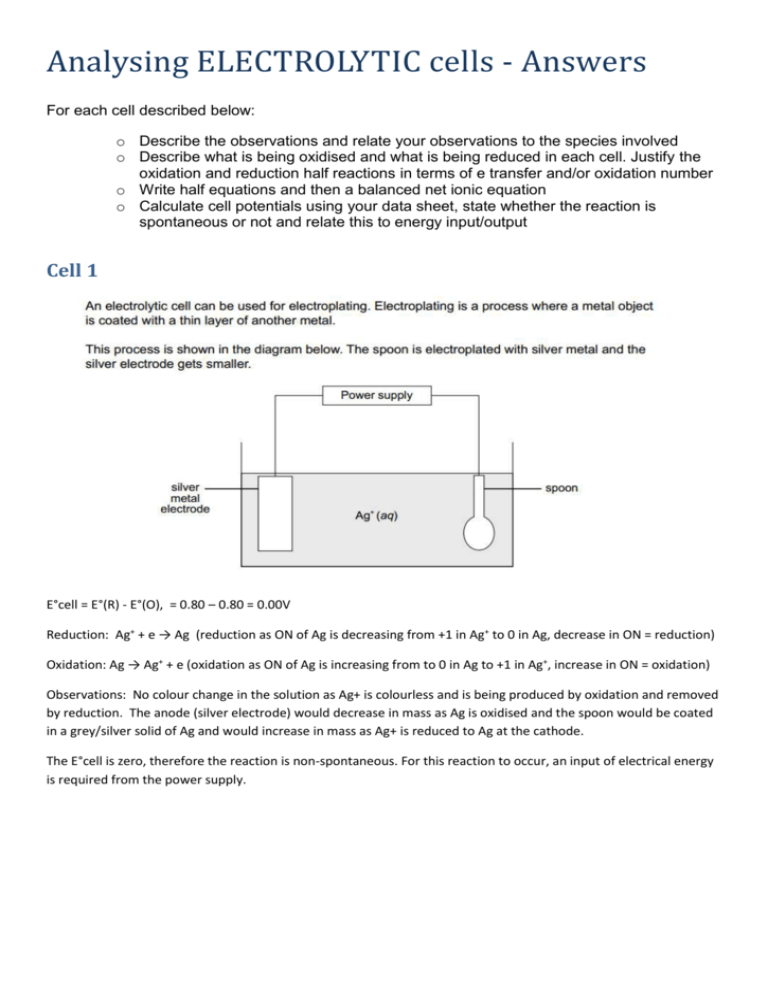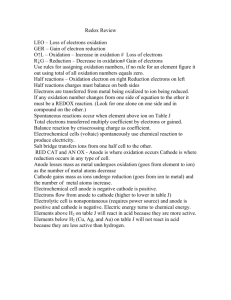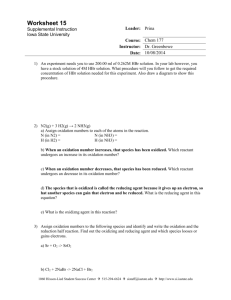Analysing ELECTROLYTIC CELLS ANSWERS
advertisement

Analysing ELECTROLYTIC cells - Answers For each cell described below: o Describe the observations and relate your observations to the species involved o Describe what is being oxidised and what is being reduced in each cell. Justify the oxidation and reduction half reactions in terms of e transfer and/or oxidation number o Write half equations and then a balanced net ionic equation o Calculate cell potentials using your data sheet, state whether the reaction is spontaneous or not and relate this to energy input/output Cell 1 E°cell = E°(R) - E°(O), = 0.80 – 0.80 = 0.00V Reduction: Ag+ + e → Ag (reduction as ON of Ag is decreasing from +1 in Ag+ to 0 in Ag, decrease in ON = reduction) Oxidation: Ag → Ag+ + e (oxidation as ON of Ag is increasing from to 0 in Ag to +1 in Ag+, increase in ON = oxidation) Observations: No colour change in the solution as Ag+ is colourless and is being produced by oxidation and removed by reduction. The anode (silver electrode) would decrease in mass as Ag is oxidised and the spoon would be coated in a grey/silver solid of Ag and would increase in mass as Ag+ is reduced to Ag at the cathode. The E°cell is zero, therefore the reaction is non-spontaneous. For this reaction to occur, an input of electrical energy is required from the power supply. Cell 2 Mg2+ must be reduced. Cl- must be oxidised. E°cell = E°(R) - E°(O), = -2.36 – 1.40 = -3.76V Reduction: Mg+2 + 2e → Mg (reduction as ON of Mg is decreasing from +2 in Mg+2 to 0 in Mg, decrease in ON = reduction) Oxidation: 2Cl- → Cl2 + 2e (oxidation as ON of Cl is increasing from to -1 in Cl- to 0 in Cl2, increase in ON = oxidation) Overall equation: Mg+2 + 2Cl- → Mg + Cl2 Observations: No colour change in the solution as Mg2+ is colourless and so is Cl-. At the anode a pale green gas of Cl2 would appear (probably wouldn’t bubble) and the cathode would be coated in a grey/silver solid/liquid of Mg. The E°cell is negative, therefore the reaction is non-spontaneous. For this reaction to occur, an input of electrical energy is required from the power supply. Cell 3 Al3+ must be reduced. O2- must be oxidised. E°cell = E°(R) - E°(O), = -2.36 – 0.82 = -3.18V Reduction: Al+3 + 3e → Al (reduction as ON of Al is decreasing from +3 in Al+3 to 0 in Al, decrease in ON = reduction) Oxidation: 2O2- → O2 + 4e (oxidation as ON of O is increasing from to -2 in O2- to 0 in O2, increase in ON = oxidation) Overall equation: 4Al+3 + 6O2- → 4Al + 3O2 Observations: No colour change in the solution as Al3+ is colourless and so is O2-. At the anode a colourless gas of O2 would appear (probably wouldn’t bubble) and the cathode would be coated in a grey/silver solid/liquid of Al. The E°cell is negative, therefore the reaction is non-spontaneous. For this reaction to occur, an input of electrical energy is required from the power supply. NB This one is not quite right (eg the ore would not be colourless and the Ecell for O2 is different )– but for the purposes of this question and using the resource sheet available this is the best possible solution. Cell 4 Cu2+ must be reduced. Cl- must be oxidised. E°cell = E°(R) - E°(O), = 0.36 – 1.40 = -1.04V Reduction: Cu+2 + 2e → Cu (reduction as ON of Cu is decreasing from +2 in Cu+2 to 0 in Cu, decrease in ON = reduction) Oxidation: 2Cl- → Cl2 + 2e (oxidation as ON of Cl is increasing from to -1 in Cl- to 0 in Cl2, increase in ON = oxidation) Overall equation: Cu+2 + 2Cl- → Cu + Cl2 Observations: Cu2+ is blue and Cl- is colourless. The blue solution would fade as Cu2+ is reduced and decreases in concentration. At the anode a pale green gas of Cl2 would appear as bubbles and the cathode would be coated in a red/brown solid of Cu. The E°cell is negative, therefore the reaction is non-spontaneous. For this reaction to occur, an input of electrical energy is required from the power supply. Cell 5 E°cell = E°(R) - E°(O), = 0.80 – 0.80 = 0.00V Reduction: Ag+ + e → Ag (reduction as ON of Ag is decreasing from +1 in Ag+ to 0 in Ag, decrease in ON = reduction) Oxidation: Ag → Ag+ + e (oxidation as ON of Ag is increasing from to 0 in Ag to +1 in Ag+, increase in ON = oxidation) Observations: No colour change in the solution as Ag+ is colourless and is being produced by oxidation and removed by reduction. The anode (silver electrode) would decrease in mass as Ag is oxidised and the spoon would be coated in a grey/silver solid of Ag and would increase in mass as Ag+ is reduced to Ag at the cathode. The E°cell is zero, therefore the reaction is non-spontaneous. For this reaction to occur, an input of electrical energy is required from the power supply. Cell 6 Zn2+ must be reduced. Cl- must be oxidised. E°cell = E°(R) - E°(O), = -0.76 – 1.40 = -2.16V Reduction: Zn+2 + 2e → Zn (reduction as ON of Zn is decreasing from +2 in Zn+2 to 0 in Zn, decrease in ON = reduction) Oxidation: 2Cl- → Cl2 + 2e (oxidation as ON of Cl is increasing from to -1 in Cl- to 0 in Cl2, increase in ON = oxidation) Overall equation: Zn+2 + 2Cl- → Zn + Cl2 Observations: Zn2+ is colourless and Cl- is colourless. There are no observations in the solution as both ions are colourless. At the anode a pale green gas of Cl2 would appear as bubbles and the cathode would be coated in a grey solid of Zn. The E°cell is negative, therefore the reaction is non-spontaneous. For this reaction to occur, an input of electrical energy is required from the power supply. Cell 7 E°cell = E°(R) - E°(O), = 0.34 – 0.34 = 0.00V Reduction: Cu+2 +2 e → Cu (reduction as ON of Cu is decreasing from +2 in Cu+2 to 0 in Cu, decrease in ON = reduction) Oxidation: Cu → Cu2+ + 2e (oxidation as ON of Cu is increasing from to 0 in Cu to +2 in Cu+2, increase in ON = oxidation) Observations: No colour change in the solution as even though Cu+ is blue, it is being produced by oxidation and removed by reduction so overall the colour would remain constant. The anode (Cu electrode) would decrease in mass as Cu is oxidised and the cathode would be coated in a red/brown solid of Cu and would increase in mass as Cu2+ is reduced to Cu at the cathode. The E°cell is zero, therefore the reaction is non-spontaneous. For this reaction to occur, an input of electrical energy is required from the power supply.








